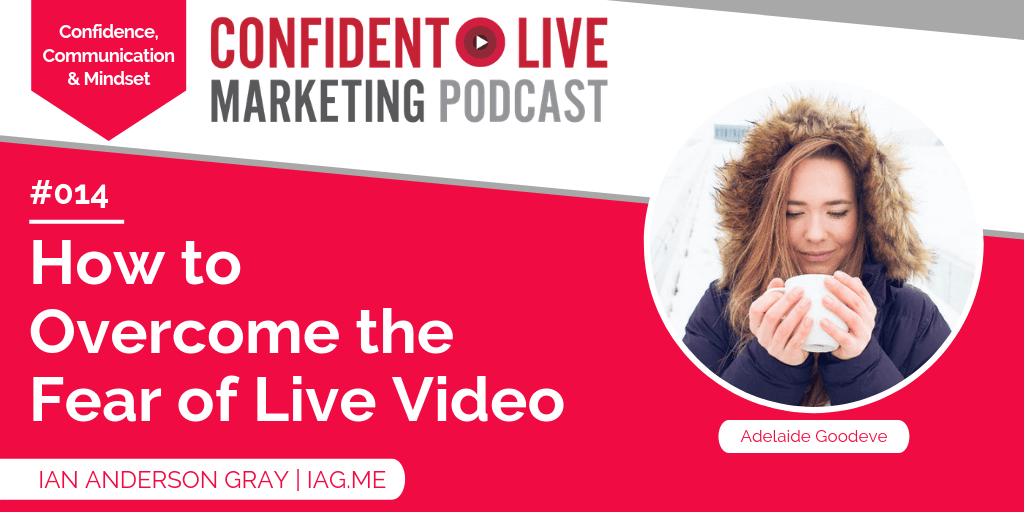How to Overcome the Fear of Live Video with Adelaide Goodeve
By Ian Anderson Gray with Adelaide Goodeve
Confident Live Marketing Podcast
Episode 14
Duration: 40 minutes 29 seconds
Episode Theme: Confidence & Mindset
August 23, 2019

In this episode, I talk to Adelaide Goodeve. She is a mindset coach and international speaker. She helps athletes and professionals sharpen the most under-utilised tool at their disposal, their brain. She works with her clients to empower them to achieve extraordinary performance.
Adelaide and I met at Janet Murray's Build Your Audience Live event, and since then I've been excited to bring her on to my podcast.
How Adelaide got started
About six or seven years ago Adelaide was diagnosed with chronic fatigue syndrome or ME. Chronic Fatigue Syndrome or ME is when someone is tired all of the time, often for unexplained reasons. This caused Adelaide to have heightened senses to sound and light, which were incredibly difficult for her to deal with. While she tried Cognitive Behavioural Therapy (CBT), it did not really work for her.
As a result of her chronic fatigue syndrome, she had to quit University and live at home and just be in bed the majority of the time. While she was doing this she would pass her time listening to various podcasts and that is when came across Rich Roll.
Rich is an ultra-endurance plant-powered athlete based in America and he has one of the top podcasts for nutrition and fitness. He has his own inspiring story, having been an alcoholic and overweight, to now becoming what Men’s Health voted as the world’s fittest man. His story really inspired her and she thought that if he could recover then she could fully recover also! This was when she really started to get serious about committing to recovery from Chronic Fatigue Syndrome.
During this time Adelaide came across the Lightning Process, which is a three-day course that teaches you how to rewire your brain. It’s a combination of neuro-linguistic programming (NLP), hypnosis, and life coaching. It teaches you to spot when you’re tricking yourself (via a trigger) to go down an unhelpful pathway and then how to stop it from travelling down that pathway and giving it any more power, and then how to change that action.
Adelaide didn’t realise this, but before committing to her recovery she would say “I’m so tired”. to herself throughout the day. With the Lightning Process, she learned how to recognize her trigger. She found that she had gotten stuck in a loop of tiredness, and in three days, she was able to fully recover by just destroying that loop and then making a new loop for energy.
Adelaide’s Tips for Overcoming Fear
Tip #1 Recognizing Negative Triggers
Self-talk is at the centre of everything. How we talk to ourselves affects our actions, behaviours and our beliefs, It’s incredibly important to watch the language we use with ourselves.
Adelaide says…
“If someone says “I’m really nervous about going on live video”, I would say to them “How would you want to feel instead?” They might say “Well, I don’t want to feel nervous about going on live video.” Believe it or not – that is still actually triggering the same pathway. Because your brain doesn’t hear ‘not nervous’, it just hears ‘nervous’ as the brain deletes “no” in any form. Unfortunately, your brain clearly understands what not to think about and is, therefore, thinking about it.
Instead, a positive reframed phrase would be “I want to feel calm, confident and excited about live video”. Once you have your powerful phrase, you will start noticing when unhelpful phrases come up, and you can change them immediately.”
Tip #2 Tips for Visual People
There are people who are more visual and they visualise how things could be. For Adelaide, she imagines having her dream guest, Lucy Charles, on her future YouTube show.
Adelaide shared how a visual person might prepare…
- First, start to start to think about how this is going to look. What would you be doing? What would your guest be doing? How would you look as you are interviewing your guest? How would they look chatting with you?
- Next, you might move to thinking about your studio set-up. Which microphone you might use, etc. If you write it down, it’s a lot easier than just thinking about it because you can start to get more into the story and it’s quite cathartic as well.
- And then you want to think about what you are going to hear. Are you going to hear your voice? Are you going to hear the voice of your guest and their story? You could even go so far as to visualise your voice sounding very confident. Just think about how exactly you want your voice to sound and what you’re going to hear.
- And then progress that thinking about how your guest’s voice is going to sound as they enjoy the conversation with you.
“From this, you can gather that when we’re visualising – we’re actually seeing and hearing sound a lot more. It’s about getting into the groove and understanding which senses are the most powerful for you and while you’d still be using your other senses, you’re really focusing on that one main one for you, which is the most powerful.”
Tip #3 Identifying and stopping Triggers
We all have triggers, but how do we identify and then stop them?
Adelaide’s Advice…
“I find meditation is a really good, useful practice for this. It’s all about just becoming more aware of them. With meditation, because your mind is a lot calmer, different things rise up and you can start to just see the triggers float by. It’s a great metaphor – you can just see them (triggers or thoughts), and then let them just float away.”
“If you don’t meditate then you can just try to make the effort to notice the thoughts coming into your mind. So, if you’re sitting quietly doing work, and you start to hear you tell yourself something – then just stop. And often just saying: “Stop!” is enough because it gives you time to pause, reflect and then ask yourself a really simple question: “Is this helping me? If it’s not, then you want to rephrase the thought into a powerful, positive and productive phrase. If it is, then that’s great! Give yourself a pat on the back and build upon the power of that thought.”
Tip #4 Preparing Your Mind to ‘Go Live’
Adelaide that when she first started podcasting she used to write a detailed script with questions she was going to ask. As time went on, she found that she no longer needed to do that because she is now comfortable with the process.
I shared that for most people, the concern is one of three things:
- Being comfortable in front of the camera
- Confidence with the technical gear
- What to talk about
Having these sorted out ahead of time can help prepare you to have the confidence to go live.
Tip #5 Achieving extra-ordinary performance with live video
Adelaide shared that to achieve an extra-ordinary live video, she will choose a simple metric. For example, having the best conversation possible, and focusing on that metric. She will then score herself on that metric on a scale of 1-10, so that she has a way to measure her success.
Adelaide used Instagram Stories to build her confidence in doing live video. She felt awkward at first, but the more she did it, the more she realized that she could do it, and then the more comfortable and confident she became.
A big thank you to Adelaide for coming to chat with me in this episode.
I think that the conversation about working towards your peak performance and what a big job mindset has to do with that will really help those of you struggling with a fear of live video.
You can find out more about Adelaide here:
Adelaide has a range of different conversations with an eclectic group of people – whether they are triathletes, CEOs or professionals. The topic is about always looking into their story and their mindset and what they found useful. Be sure to look out for the one with Megan Hein who’s an adventurer, and she’s actually a survival expert as well (the lady behind Bear Grylls).
Watch Episode 14

About Adelaide Goodeve
Adelaide is a mindset coach and international speaker. She helps athletes and professionals sharpen the most under-utilised tool at their disposal, their brain. She works with her clients to empower them to achieve extraordinary performance.

